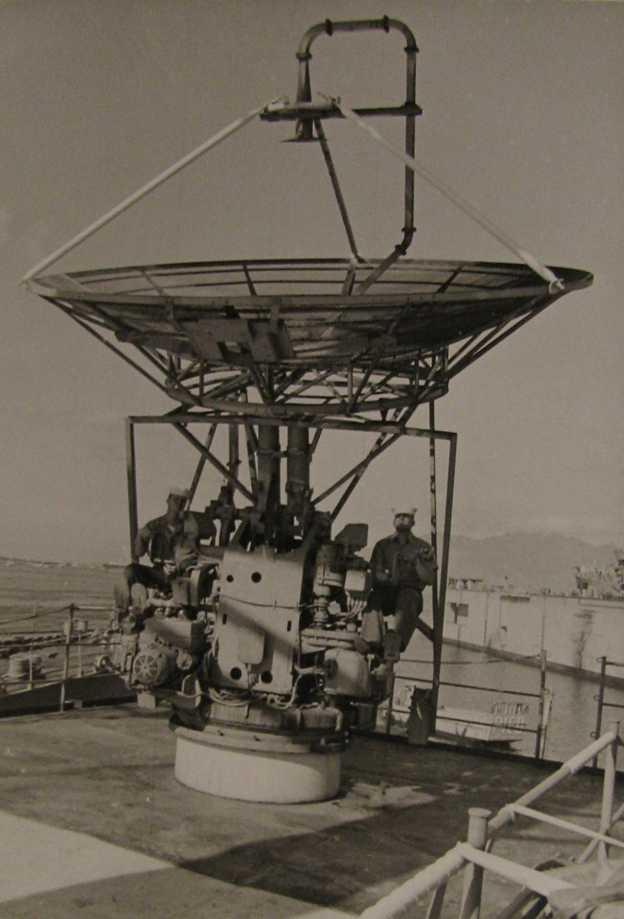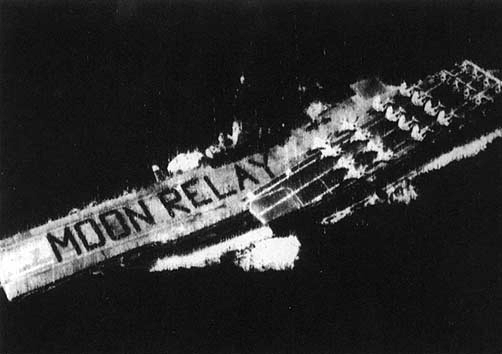Image: Wikimedia Commons
On July 24, 1954, a Navy engineer named James Trexler sat in a room at the Naval Research Center in Maryland talking to himself. To the outside observer, the situation would certainly look strange. But Trexler hadn't gone mad—he'd just inaugurated electronic warfare.To be more specific, Trexler was speaking into a microphone connected to a large antenna at the Stump Neck radio facility at the Naval base. This antenna was directed toward the moon and when Trexler spoke into microphone, his words returned to him two and a half seconds later after traveling a 500,000 mile circuit to the moon and back. Although the first radio signal had been bounced off the moon nearly 30 years earlier, Trexler was the first to send and receive a voice transmission via the moon.The origins of this landmark experiment lie in Trexler's college days, when he first realized that the moon's ionosphere could serve as a reflector for radio waves. When he joined the Naval Research Center in the late 1940s, he pushed his hypothesis even further and pondered whether the moon might be used as a "radar intercept device" capable of spying on Soviet communications. Over the next two years, Trexler focused most of his energies on proving that a moon radio intelligence program was viable. By 1950, the US Navy was convinced that there was some validity to Trexler's idea and constructed two large antennas in an attempt to monitor Soviet radio communication signals. And so the top secret Passive Moon Relay (PAMOR) project was born.The PAMOR project only enjoyed moderate success. In 1964, it managed to use the moon to intercept a Soviet signal from the sophisticated "Hen House" radio dish in the Southeastern Soviet Union. This dish had long been a fascination of the US military since it had first been discovered after radio waves were refracted from the cloud of a nuclear bomb test in the USSR. Other attempts to turn the moon into a passive eavesdropping device were only moderately successful.A 1940s newsreel discussing Project Diana, a precursor to Operation Moon Bounce.Shortly after the creation of PAMOR, Trexler and his supervisor Howard Lorenzen (the "father of electronic warfare") established radar contact with the moon in October of 1951. The project only involved sending and receiving a series of short pulses to test the fidelity of using the moon as a communications relay device.This was six years before the first artificial satellite would be placed in orbit, and the military was still dependent on skywave transmission to send its radio signals to its deployments around the world. This involved refracting radio waves from the Earth's ionosphere—an upper layer of the atmosphere with a high concentration of electrically charged atoms—in order make contact with its units on the other side of the world. While this worked well enough, it was also an unreliable communication mechanism—solar flares and geomagnetic storms made skywave transmissions impossible.
By 1950, the US Navy was convinced that there was some validity to Trexler's idea and constructed two large antennas in an attempt to monitor Soviet radio communication signals. And so the top secret Passive Moon Relay (PAMOR) project was born.The PAMOR project only enjoyed moderate success. In 1964, it managed to use the moon to intercept a Soviet signal from the sophisticated "Hen House" radio dish in the Southeastern Soviet Union. This dish had long been a fascination of the US military since it had first been discovered after radio waves were refracted from the cloud of a nuclear bomb test in the USSR. Other attempts to turn the moon into a passive eavesdropping device were only moderately successful.A 1940s newsreel discussing Project Diana, a precursor to Operation Moon Bounce.Shortly after the creation of PAMOR, Trexler and his supervisor Howard Lorenzen (the "father of electronic warfare") established radar contact with the moon in October of 1951. The project only involved sending and receiving a series of short pulses to test the fidelity of using the moon as a communications relay device.This was six years before the first artificial satellite would be placed in orbit, and the military was still dependent on skywave transmission to send its radio signals to its deployments around the world. This involved refracting radio waves from the Earth's ionosphere—an upper layer of the atmosphere with a high concentration of electrically charged atoms—in order make contact with its units on the other side of the world. While this worked well enough, it was also an unreliable communication mechanism—solar flares and geomagnetic storms made skywave transmissions impossible. With these new experiments, codenamed Operation Moon Bounce, the US military hoped to turn the moon into a natural communications satellite. After a series of successful tests, the US military turned Operation Moon Bounce into a fully operational communications system, which was used to link Hawaii with Washington DC beginning in 1959. In 1960, the system was officially inaugurated with a transmission between two Naval officers. It consisted of an image of a boat where the sailors had spelled out 'MOON RELAY.'Although this system of communication was used and expanded for a number of years, by the late 1960s it had become obsolete due to the increasing number of artificial communication satellites being launched by the US military. Yet these artificial satellite communication networks were built using lessons learned from Operation Moon Bounce, one of the Cold War's most audacious military designs.As a now declassified document about the Moon Bounce program admits, "the Moon Bounce effort is one of those intelligence collection techniques which seemed at first 'far out' but has in the event more than paid for itself."
With these new experiments, codenamed Operation Moon Bounce, the US military hoped to turn the moon into a natural communications satellite. After a series of successful tests, the US military turned Operation Moon Bounce into a fully operational communications system, which was used to link Hawaii with Washington DC beginning in 1959. In 1960, the system was officially inaugurated with a transmission between two Naval officers. It consisted of an image of a boat where the sailors had spelled out 'MOON RELAY.'Although this system of communication was used and expanded for a number of years, by the late 1960s it had become obsolete due to the increasing number of artificial communication satellites being launched by the US military. Yet these artificial satellite communication networks were built using lessons learned from Operation Moon Bounce, one of the Cold War's most audacious military designs.As a now declassified document about the Moon Bounce program admits, "the Moon Bounce effort is one of those intelligence collection techniques which seemed at first 'far out' but has in the event more than paid for itself."
Advertisement

Advertisement

